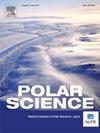Bromine chemistry plays an important role in tropospheric ozone depletion events in polar regions. Autocatalytic reactions lead to bromine explosion events, causing ozone depletion to near-zero levels in the polar troposphere. Bromine chemistry over Antarctica is not fully understood, and ground-based observations are scarce. This work presents year-long observations of bromine oxide (BrO) over the Bharati station (69.41°S, 76.19°E) using Multi-axis Differential Optical Absorption Spectroscopy (MAX-DOAS) from December 2018 to February 2020. The results show that elevated BrO mixing ratios were found during spring (September), with a maximum value of 10.21 ± 4.38 pptv for clear sky conditions and 33.15 ± 2.23 pptv for cloudy conditions. BrO was not observed above the detection limit (∼3 × 1013 molecule cm−2) outside spring on clear days. In general, lower mixing ratios were observed on clear days over Bharati compared to stations in West Antarctica. This indicates a different source strength over East Antarctica compared to West Antarctica. BrO vertical column densities were high during spring, with a maximum value of 1.34 ± 0.35 × 1014 molecule cm−2. The vertical profiles of the BrO mixing ratios show a peak at the surface during spring (average of 6.5 ± 1.91 pptv), decreasing sharply with altitude. Back trajectories show that air masses passing over the first year ice showed higher BrO, although factors such as meteorology play an important role in determining the absolute levels. Using a box model, we show that bromine chemistry can deplete as much as 2.15 ppb of ozone in a day at the Bharati Station on clear days, which shows that it does not lead to complete ozone depletion events over Bharati.


